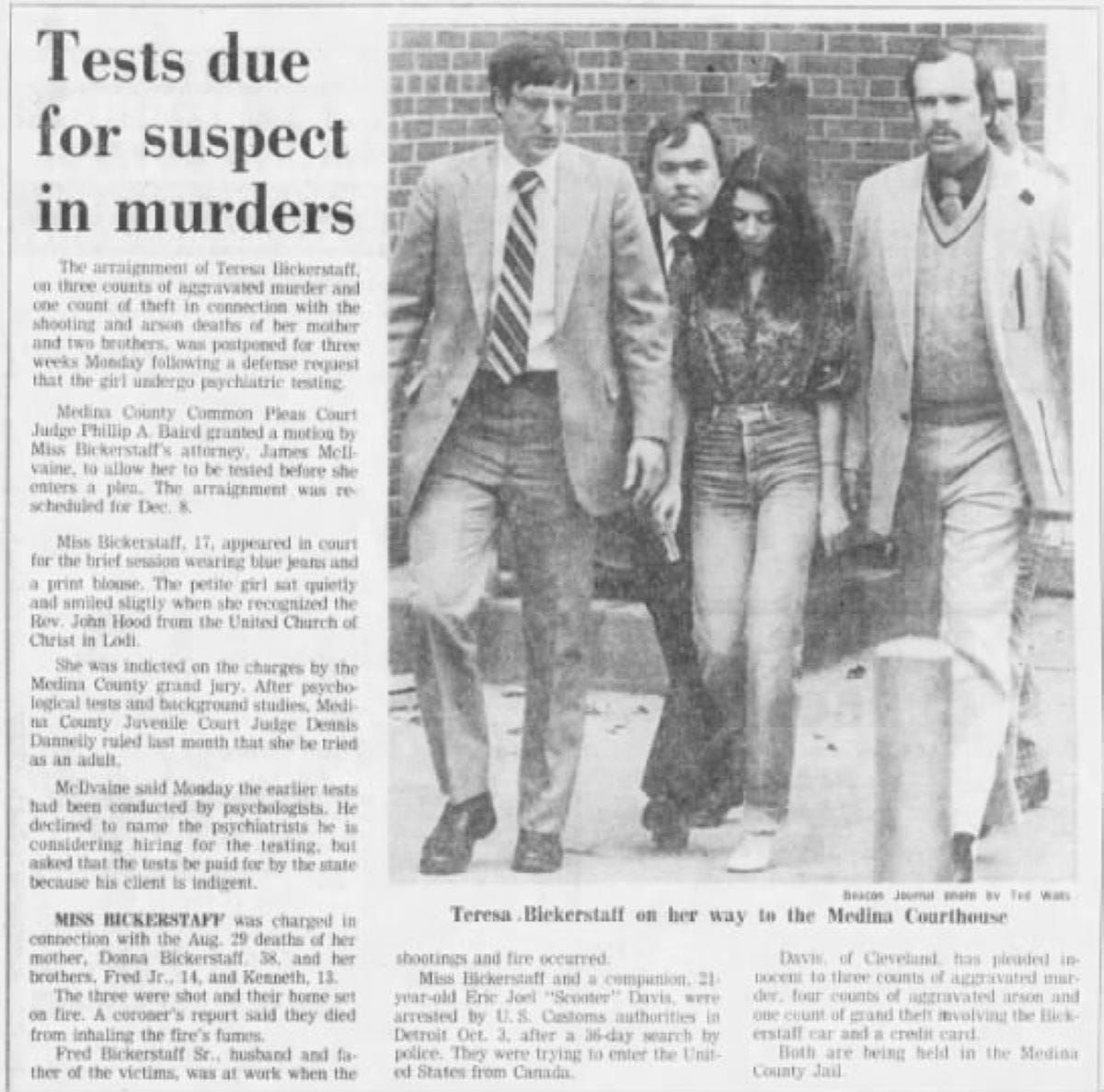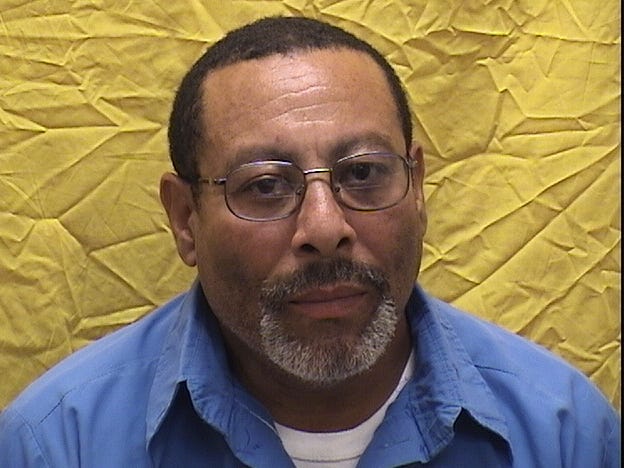I Went To School With A Murderer
Teresa Bickerstaff killed her mother and two brothers. But why?
I still remember her like it was yesterday.
She stalked the halls of our junior high school in a long, coat-like sweater with a belt that dangled down on both sides. I can’t picture her without the sweater.
A lot of girls wore sweaters like that in the ‘70s, mostly stoners and “bad girls”. The rest of us were wearing polo shirts with vests and popped collars, and those weird scarves with the knotted ends.
Teresa’s hair was striking — long and black. She always had it styled in sausage-roll curls that framed her face. We all wore those same curls. We were hiding behind them.
But Teresa had more to hide than the rest of us.
Honestly, Teresa Bickerstaff scared me and I always gave her a wide berth. If I saw her coming down the stairs from the library towards the lockers, I’d circle around to avoid her.
She shouldn’t have even been in my school. Junior high was grades seven through nine, and she’s four years older than me. But she started running away from home when she was 14, so maybe she was held back, or maybe she was visiting her friends.
Her youngest brother, Ken, was two grades ahead of me, so I knew him just from seeing him around. He was one of the cool kids—slim build, good looking in that late ‘70s way when boys still wore their hair in a floaty, Shaun Cassidy cut.
I doubt I ever spoke to Ken, and I didn’t know Fred Bickerstaff, Jr. at all since he was three years ahead and already in high school.
It’s funny how I can’t picture her without the sweater.
Teresa was clearly troubled. But back then we didn’t ask questions like, “Why are you troubled? Why are you running away from home and turning tricks when you should be going to football games and playing in the marching band?”
Our little rural community was not equipped to ask those kinds of questions. And family secrets were just that—secrets.
Teresa met her boyfriend, Eric “Scooter” Davis, in rehab. Scooter was a Black man five years her senior. Needless to say, that didn’t go over well in very white, very conservative Lodi, Ohio.
So they decided to run away together. Not just to Cleveland, but someplace farther away. A longer trip that would require money and a car.
As it turned out, Teresa’s father, Fred Bickerstaff Sr., had guns they could sell and a second car they could steal.
On the evening of August 29, 1980, Scooter had a friend drop him off near the Bickerstaff residence on Kennard Road. Fred Sr. worked the night shift at the Alcoa plant in Cleveland and left around 9:30 p.m. Teresa’s mother, Donna, and the two boys went to bed, while Teresa waited for Scooter to show up. He loaded the gun Teresa had waiting for him.
Teresa and Scooter’s accounts of what happened next diverge. At first, Teresa took the blame for shooting her mother when she awoke and confronted her, and then shooting her brothers as they lay in their beds.
She never mentioned stabbing both boys— Kenny 12 times and Fred Jr. once—in the kind of overkill that murder experts say proves a deep emotional attachment between the perpetrator and the victim.
According to Scooter, she came barreling out of the bedroom after the shootings screaming, “My brothers aren’t dead!”
At that point, he gathered up their things—Teresa’s clothing and her father’s guns—ushered her out of the house, and then set it on fire using a can of gasoline he found in the garage.
When the house went up in flames with no sign of Teresa’s body in the wreckage, the first thought was that she had been kidnapped. Of course, everybody immediately blamed Scooter for everything.
But Teresa confessed to authorities when they were picked up in Detroit on their way back from Canada. She was the shooter, not Eric Davis.
But how did tiny Teresa Bickerstaff even shoot a gun? Guns are heavy. She was five feet tall and weighed 90 pounds, “pixie-like” as she sat hunched in the witness chair. How did she lift a gun, aim, and pull the trigger multiple times?
Conveniently, the State found a witness who testified that Teresa had once pulled a gun on her during an argument and that she had seen Teresa shoot a gun out a window at a parked truck, thereby establishing that she knew how to handle firearms.
Teresa would later say she took the fall for her boyfriend because they felt she’d have a better chance at escaping a life sentence as a juvenile. Also, as a Black man in Medina County, he was already guilty.
Unfortunately for Teresa, although the case started in juvenile court, it was bounced upstairs to Courtroom No. 2 (where I used to work) when it was determined that she would be tried as an adult.
Teresa’s case took over a year and a half to come to trial. Her attorney, Jim McIlvaine, buried the State in motions to stall for time, let emotions cool and memories fade. He was a partner in one of the county’s most prestigious law firms. Today, his brother is a judge.
Teresa allegedly recanted her confession at trial because Eric had sent her letters from the jail asking her to claim that her family was already dead before she even let him in the house, thereby absolving him of any involvement whatsoever.
It’s more likely that her self-preservation instincts finally kicked in. She even managed to conjure a touching scenario wherein she came upon her dying mother (after having been shot by Eric), knelt, and cradled her in her arms.
Of course, the biggest bombshell was the allegation that Fred Bickerstaff Sr. had been sexually abusing his daughter for years.
Both defense attorneys tried mightly to get those allegations before the jury, Davis’s attorney to paint Eric as a savior, and Teresa’s attorney to paint her as a victim:
“MR. WILLIS [attorney for Eric Davis]: The evidence will show that when this young girl was in the sixth grade, that she engaged in fellatio with her father, at his insistence; that this relationship continued almost unabated until she was fourteen years old, and included sexual intercourse in addition to fellatio.
“The evidence will show that when she was fourteen years of age, she was a drug addict, that her father was abusive to her, and that she ran away, * * *.”
The Court found that such testimony would be “a distraction” from the charges with which Davis was charged. They further asked, if Fred Sr. had been the subject of Teresa’s murderous rage, why did she kill everybody but him?
Fred Bickerstaff Sr. was a stern figure with a drooping, handle-bar mustache. When he was put on the stand, he stated, “I never had sexual intercourse with Teresa.” John Porter, the assistant prosecuting attorney, told him to face the jury and repeat his statement, which he did in a “firm, strong voice.”
Of course, such an assertion leaves much room for other, unstated forms of abuse.
The Bickerstaff family was broken long before the murders. An uncle testified that one of the boys told him he hated Teresa. Teresa testified that her brothers would offer her to their friends for sex, and that her mother laughed at her pleas for help.
Although Teresa stated that her father beat her, witnesses would testify that they never saw her with bruises or visible signs of abuse. She said that shortly before the murders, after her father chased Eric down the driveway, he beat her yet again, leading her to hatch the lovers’ plot to run away together.
Every time Teresa comes up for parole, we as a community relive the murders all over again. Her next chance at freedom is 2023.
A woman who served time with Teresa in prison wrote on Facebook “she has learned from her mistakes and is truly heartbroken.” Teresa teaches yoga and goes to church.
She’s in prison. What else is she going to do?
Our understanding of the effects of long-term sexual and physical abuse has grown immeasurably since 1980. Does that excuse Teresa’s and Eric’s actions? Of course not.
But I can’t help feeling that Teresa’s life had already been devalued before the jury came back with their decision because she was a white girl having sex with a Black man in 1980. McIlvaine told the men and women of the jury that the evidence would be “ugly, gruesome, and shocking to our senses of decency and our moral codes.”
He meant an interracial love affair as much as the allegations of incest.
Did Teresa Bickerstaff snap? Did she kill her mother and brothers by shooting them and stabbing them repeatedly in a frenzy of hatred?
Probably. Situations present themselves, and all of the pieces were there—the gun, the knife, an unstable girl who was running away to make a new life. All those years of abuse and indifference.
Both defendants of course appealed their convictions on various bases. The most urgent appeals centered around premediation, which was the difference between a lesser charge of manslaughter and aggravated murder, which carried a life sentence.
Were the murders premeditated?
Why would Teresa need a loaded gun just to sneak some clothes and guns out of the house? Why did Eric need to be there at all? Teresa could have loaded everything into the car while the others slept and peeled out, picking Eric up down the road.
Teresa Bickerstaff and Eric Davis have been in prison since 1980, their entire adult lives.
Sources: Ohio Ninth District Court of Appeals; Killer Kids: Shocking True Stories Of Children Who Murdered Their Parents (Clifford L. Linedecker, 2011)







As I read about her stabbing both brothers, I thought, they were sexually abusing her. And the dad, of course. And the mom did nothing. This sick family dynamic is far too common.
Gruesome story, though superbly written. In small towns tragic events like these stay with the community for generations.